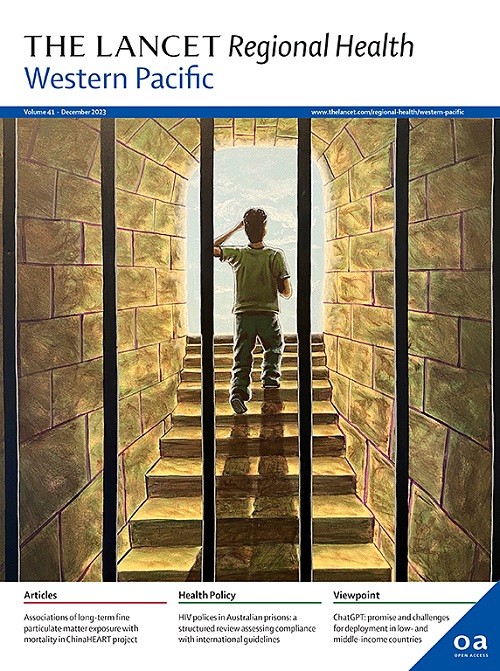Comprehensive systematic review and meta-analysis of risk factors for childhood obesity in China and future intervention strategies
IF 8.1
1区 医学
Q1 HEALTH CARE SCIENCES & SERVICES
引用次数: 0
Abstract
Background
Childhood obesity is a critical public health concern in China. This study identified the key determinants of childhood obesity in China and provided recommendations for future intervention strategies.
Methods
We conducted a comprehensive systematic review and meta-analysis to identify multiple-level determinants of childhood obesity in China and calculated the population-attributable risk percentage (PAR%) for each modifiable determinant. We also conducted expert consultations using the Socio-ecological Model to gain insights into the causes of obesity. Additionally, we reviewed current Chinese policies on childhood obesity intervention and compared them with the priorities identified in the meta-analysis and expert consultation to pinpoint policy gaps.
Findings
Our meta-analysis, incorporating 419 studies, identified 33 risk factors for childhood obesity. At the individual-level, we identified 11 key contributors including early-life risk factors such as maternal pre-pregnancy overweight/obesity (PAR%: 16.7%), breastfeeding duration of less than six months (14.1%), cesarean section delivery (11.1%), excessive gestational weight gain (10.5%), high birth weight (4.2%), and gestational diabetes mellitus (3.6%), and 13 behavioral factors during childhood such as sugar sweetened beverage consumption (16.4%), insufficient sleep (15.0%), rapid eating speed (14.7%), less than 2 h of physical activity per day (6.3%), and over 2 h of daily screen time (5.6%). We also identified six prominent family-level factors such as maternal overweight/obesity (24.3%) and paternal overweight/obesity (23.5%). Expert consultation highlighted genetic factors, and prioritized actionable risk factors, particularly dietary, expanding on the meta-analysis findings. Finally, policy review revealed that existing Chinese policies inadequately addressed these determinants, especially at the macro and structural levels.
Interpretation
This study highlights the importance of targeting high-risk populations and addressing detrimental behavioral factors, especially on early-life influences. However, real-world impacts require a comprehensive approach that goes beyond individual factors. More future effective intervention efforts are needed.
Funding
This study was funded by the National Natural Science Foundation of China (NSFC 82073567; NSFC 82273641) and the National Science and Technology Innovation 2030, Noncommunicable Chronic Diseases-National Science and Technology Major Project (Grant No. 2023ZD0508500, 2023ZD0508504).
中国儿童肥胖危险因素的综合系统回顾和荟萃分析及未来干预策略
儿童肥胖是中国一个重要的公共卫生问题。本研究确定了中国儿童肥胖的关键决定因素,并为未来的干预策略提供了建议。方法我们进行了一项全面的系统回顾和荟萃分析,以确定中国儿童肥胖的多水平决定因素,并计算每个可改变决定因素的人口归因风险百分比(PAR%)。我们还利用社会生态模型进行了专家咨询,以深入了解肥胖的原因。此外,我们回顾了中国目前的儿童肥胖干预政策,并将其与荟萃分析和专家咨询中确定的优先事项进行了比较,以确定政策差距。我们的荟萃分析纳入了419项研究,确定了33个儿童肥胖的危险因素。在个人层面,我们确定了11个关键因素,包括早期生活风险因素,如母亲孕前超重/肥胖(PAR%:16.7%),母乳喂养时间少于6个月(14.1%),剖宫产(11.1%),妊娠体重增加过多(10.5%),出生体重高(4.2%),妊娠糖尿病(3.6%),以及儿童时期的13个行为因素,如含糖饮料摄入(16.4%),睡眠不足(15.0%),进食速度快(14.7%),每天运动时间少于2小时(6.3%),每天看屏幕时间超过2小时(5.6%)。我们还确定了六个突出的家庭水平因素,如母亲超重/肥胖(24.3%)和父亲超重/肥胖(23.5%)。专家咨询强调了遗传因素,并优先考虑了可采取行动的风险因素,特别是饮食,扩大了荟萃分析的结果。最后,政策回顾显示,中国现行政策未能充分解决这些决定因素,特别是在宏观和结构层面。本研究强调了针对高危人群和解决有害行为因素的重要性,特别是对早期生活的影响。然而,现实世界的影响需要一种超越个人因素的综合方法。未来需要更多有效的干预努力。基金资助:国家自然科学基金(NSFC 82073567;国家科技创新2030项目,非传染性慢性病国家科技重大专项(批准号:2023ZD0508500, 2023ZD0508504)。
本文章由计算机程序翻译,如有差异,请以英文原文为准。
求助全文
约1分钟内获得全文
求助全文
来源期刊

The Lancet Regional Health: Western Pacific
Medicine-Pediatrics, Perinatology and Child Health
CiteScore
8.80
自引率
2.80%
发文量
305
审稿时长
11 weeks
期刊介绍:
The Lancet Regional Health – Western Pacific, a gold open access journal, is an integral part of The Lancet's global initiative advocating for healthcare quality and access worldwide. It aims to advance clinical practice and health policy in the Western Pacific region, contributing to enhanced health outcomes. The journal publishes high-quality original research shedding light on clinical practice and health policy in the region. It also includes reviews, commentaries, and opinion pieces covering diverse regional health topics, such as infectious diseases, non-communicable diseases, child and adolescent health, maternal and reproductive health, aging health, mental health, the health workforce and systems, and health policy.
 求助内容:
求助内容: 应助结果提醒方式:
应助结果提醒方式:


